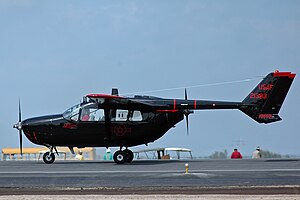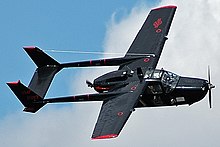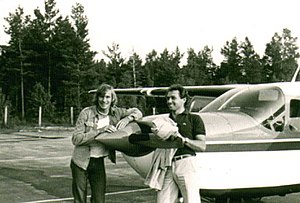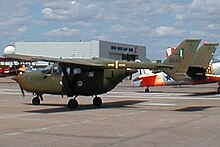Cessna Skymaster
| Cessna 336/337 | |
|---|---|
 Cessna O-2 Skymaster |
|
| Type: | twin-engine light aircraft |
| Design country: | |
| Manufacturer: | |
| First flight: |
336: February 28, 1961 |
| Commissioning: |
1963 |
| Production time: |
1963 to 1982 |
| Number of pieces: |
2993 |
The Cessna 336 Skymaster and 337 Super Skymaster are six-seat, twin-engine propeller - driven shoulder -wing planes produced by the US aircraft manufacturer Cessna Aircraft Company. They were manufactured between 1963 and 1982 in several civil and military versions. Only a prototype of the military turboprop variant Cessna 348 (O-2T) was built.
Due to the current emission protection regulations in Germany, the Skymaster can only be used to a limited extent due to its considerable noise generation.
construction
After extensive research, Cessna chose a rather unusual design for the Skymaster , the so-called central thrust system . The fuselage was constructed as a nacelle with a motor with a pulling propeller at the bow and a motor with a pusher propeller at the stern. The arrangement of the two motors in the central axis of the aircraft has the advantage over the classic arrangement on the wings that if one motor fails, there is no yawing around the vertical axis. This allows the vertical tail to be made smaller. This makes the Skymaster easier to control in the event of an engine failure and saves fuel in normal operation. The cooling problems of the rear engine could never really be resolved. There were several take-off accidents because the tail engine had already failed while taxiing, unnoticed by the pilot.
The soundproofed fuselage was made in all-metal half-shell construction and has only one door, which is located on the right-hand side. Heating and ventilation are standard.
The wings , designed in a shoulder- wing arrangement, are braced towards the underside of the fuselage. The tail unit is designed as a double tail unit , which is located at the ends of booms that protrude from the wing trailing edge to the rear. With this relatively simple design, Cessna promised low production costs, more safety and, above all, easier flight handling.
The wings have electrically operated slotted flaps , at the customer's request the wings and tail unit were equipped with a pneumatic de-icing system.
The aircraft has a retractable landing gear with a steerable nose wheel and hydraulically operated disc brakes.
Construction of the Skymaster began on January 25, 1960, a dummy was built in July 1960.
variants
Model 336
The first Skymaster model was the 336 series . This version with a rigid tricycle landing gear had its maiden flight on February 28, 1961.
Series production began after the FAA was granted type approval in 1963; A total of 195 machines of the 336 , which was equipped with two Continental IO-360-A engines with an output of 157 kW each, were produced by mid-1964.
In addition to the standard cockpit design for 4 people, equipment variants for up to 6 people were also possible.
As far as known, there are only two Cessna 336 left in Germany as of 2010 .
From 1975 to 1979 a Cessna 336 was used in Koblenz- Winningen for taxi and sightseeing flights. This machine was later operated by a private person in Koblenz and then sold to Worms .
Model 337
The type 337 Super Skymaster (later the "Super" was dropped in the name and the name was changed to 337 Skymaster ) had its maiden flight on March 30, 1964 and was presented by Cessna in 1965. This machine had slightly larger dimensions than the 336 , more powerful engines, a retractable landing gear and due to the overheating problems of the rear engine, which often occurred with the previous model, an additional air inlet for this. The first flight of the machine took place on March 30, 1964. All in all, there were types 337A to 337H until the end of production in 1980, and from 337C onwards they could also be equipped with supercharged engines. The models 337G and 337H were also available from 1974 in a version with a pressurized cabin , which was then sold as the P337 "Pressurized Skymaster". You can recognize this by the smaller, rounded cabin windows and the two-part pressure-tight door compared to the other versions. A luxury version was the T337GP, which was equipped with a pressurized cabin and supercharged engines. A total of 2678 machines (including 356 with a pressurized cabin) of the various 337 variants were built in the USA.
Model T337 / T377G
In 1967 the T377 , a Skymaster with turbocharging , and in 1972 the pressurized version T377G appeared .
Military variant O-2
The Cessna O-2 is a twin-engine military aircraft produced by the US aircraft manufacturer Cessna Aircraft Company based on the civilian model 337 "Skymaster".
history
Due to the experience during the Vietnam War , the USAF had a need for small aircraft for the air traffic control service , whereby these machines were to be manned by a so-called forward air controller , the observer, in addition to the pilot . Last but not least, these aircraft should replace the now outdated Cessna O-1 Bird Dog . In the film Apocalypse Now such a machine was seen in this role, in the film BAT-21 a machine of this type (flown by Danny Glover as pilot "Birddog") is an important part of the plot.
In order to save the costs of a new development, a suitable series product was sought for this purpose. At the end of 1966, the choice fell on the Cessna 337 Skymaster.
Externally, the O-2 (the O stands for the English word observation ) differed from the 337 only in that it had additional windows for the observer and the four carriers attached to the wings for external loads. Luminaries, light weapons or missiles could be attached to these carriers. In contrast to the civilian variant, the O-2s were equipped with radio and navigation systems that were extremely modern for the time.
The full name of the standard version of this aircraft, of which a total of 501 units were delivered to the US Air Force and 12 units to the Iranian Air Force at the beginning of 1970 , was O-2A.
The US Air Force decommissioned its last O-2s in the 1980s.
Variant O-2B
For the psychological warfare 31 machines, each with three 600 were watts paid audio amplifiers , directional speakers and a discharge device for flyers equipped. These aircraft, built as civilian Cessna 337s, were given the designation O-2B . Furthermore, these were not provided with the additional windows for the observer.
Variant O-2T
Under the type designation Cessna 348 (military: O-2T), a prototype equipped with two turboprop engines from the Allison 250 series with 317 WPS each completed its maiden flight in the autumn of 1969 . The performance data of this version planned as a fire control aircraft were improved accordingly. Derived from the O-2B, the series version O-2TT with an extended fuselage (9.85 m) and a larger wing (wingspan 13.11 m / wing area 18.81 m²) was to emerge, but this was not realized.
Basis for a flying car

It also served as the basis for the AVE Mizar flying car , which crashed during a test flight.
Military users
-
 Ethiopia
Ethiopia
-
 Argentina
Argentina
-
 Bangladesh
Bangladesh
-
 Belgium
Belgium
-
 Benin
Benin
-
 Burkina Faso
Burkina Faso
-
 Chile
Chile
-
 Costa Rica
Costa Rica
-
 Ecuador
Ecuador
-
 El Salvador
El Salvador
-
 France
France
-
 Gabon
Gabon
-
 Guinea
Guinea
-
 Guinea-Bissau
Guinea-Bissau
-
 Haiti
Haiti
-
 Iran
Iran
-
 Jamaica
Jamaica
-
 Colombia
Colombia
-
 Liberia
Liberia
-
 Libya
Libya
-
 Mauritania
Mauritania
-
 Mexico
Mexico
-
 Nicaragua : 8 × 0-2A, 1 × 0-2B
Nicaragua : 8 × 0-2A, 1 × 0-2B -
 Niger
Niger
-
 Pakistan
Pakistan
-
 Paraguay
Paraguay
-
 Peru
Peru
-
 Portugal
Portugal
-
 Sri Lanka
Sri Lanka
-
 Rhodesia
Rhodesia
-
 Zimbabwe
Zimbabwe
-
 South Vietnam
South Vietnam
-
 South Africa
South Africa
-
 South Korea
South Korea
-
 Singapore
Singapore
-
 Sweden
Sweden
-
 Swaziland
Swaziland
-
 Thailand
Thailand
-
 Togo
Togo
-
 Chad
Chad
-
 Trinidad and Tobago
Trinidad and Tobago
-
 Venezuela
Venezuela
-
 United States
United States
-
 Vietnam
Vietnam
-
 Zaire
Zaire
-
 Central African Republic
Central African Republic
Technical specifications
| Parameter | Data |
|---|---|
| crew | 1 |
| Passengers | 5 |
| length | 9.07 m |
| span | 11.62 m |
| height | 2.79 m |
| Wing area | 18.81 m² |
| Wing extension | 7.2 |
| Empty mass | 1264 kg |
| Max. Takeoff mass | 2100 kg |
| drive | two Continental motors IO-360-GB with 157 kW power / 210 PS each |
| Cruising speed | 315 km / h at 1675 m |
| Top speed | 332 km / h at sea level |
| Rate of climb | 366 m / min |
| Service ceiling | 5485 m |
| Range | 2288 km at an altitude of 3050 m |
Production numbers
By the end of production in 1980, Cessna had produced a total of 1859 “standard” or turbo- powered Skymasters, plus 332 T337G machines . There are also 513 military versions, known under the type designation O-2 .
Cessna Skymaster were exported to Germany, France , Iran , Libya , Mauritania , the Netherlands , Pakistan , Peru , Portugal and Sri Lanka, among others . Today only a few copies exist. A T337G is stationed at the Würzburg-Schenkenturm airfield.
License manufacturing
In addition to production at Cessna, a total of 94 Skymasters were manufactured under license by the French aircraft manufacturer Reims Aviation ; the civil version under the name FTB337 , the military version under the name FTMA Milirole.
The Skymaster concept today
The company Riley sells a subtle modification as Skyrocket.
The basic drive concept of the Skymaster was used in the Adam M-309 (developed by Scaled Composites ) and the resulting series version Adam A500 from Adam Aircraft Industries ; The Adam A500 had its maiden flight on July 11, 2002, and delivery of the machines began in December 2005.
See also
Web links
Individual evidence
- ^ McClellan, J Mac: Adam A500. Flying Magazine pp. 52-58. Hachette Filipacchi Media US, December 2007. ISSN 0015-4806
- ^ Rod Simpson: The General Aviation Handbook . Midland Publishing, Hinckley (UK) 2005, ISBN 1-85780-222-5 , p. 88.
- ↑ FliegerRevue 12/2008, p. 67, collector's series Cessna 337 Skymaster
- ^ William Green: Airplanes of the World, 1970/71. Werner Classen Verlag, Zurich 1970, p. 58f.
- ^ Peter Alles-Fernandez: Airplanes from A to Z, Volume 1. Bernard & Graefe Verlag, Koblenz 1987, ISBN 3-7637-5904-2 , p. 406.
- ↑ World Air Forces ( Memento of the original from July 16, 2012 in the Internet Archive ) Info: The archive link was inserted automatically and has not yet been checked. Please check the original and archive link according to the instructions and then remove this notice.
- ↑ Michael Taylor: Encyclopedia of Modern Military Aircraft. Gallery Books, 1987, ISBN 0-8317-2808-6 , p. 67.
- ↑ http://www.superskyrocket.com/





